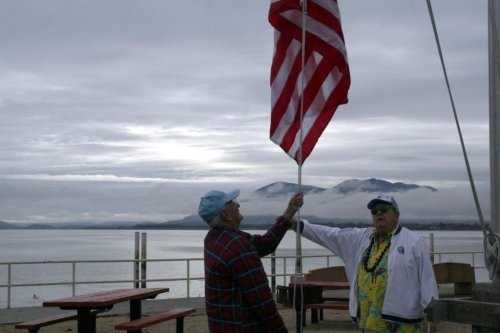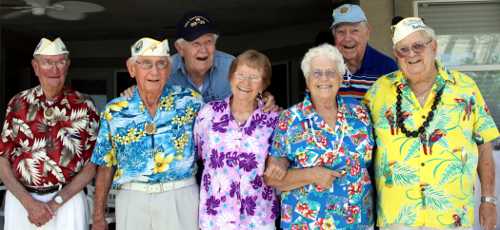- Elizabeth Larson
- Posted On
In wake of colleague's shooting, Thompson carries on with business of governing
The Jan. 8 shooting of Rep. Gabrielle Giffords in Tucson – allegedly by a mentally disturbed 22-year-old, Jared Loughner – has given rise to numerous debates about the shooter's possible motivations, and also has raised questions about the safety of the other 434 House members and 100 senators.
North Coast Congressman Mike Thompson (D-St. Helena) said security is normally a topic of consideration for Congress, but he told Lake County News in an interview this week that he, personally, doesn't plan on changing how he approaches his district.
“I think that the same security issues are in place now that have been,” said Thompson, who is in the district this week and set to return to Washington next Tuesday.
The United States Capitol Police, which is taking part in the investigation into the Giffords shooting, said in a Jan. 8 statement that while it doesn't discuss specifically discuss the security of members of Congress, it communicated with lawmakers, “advising them to take reasonable and prudent precautions regarding their personal safety and security.”
The basic common practice, said Thompson, is to alert law enforcement to any possible threats or other safety concerns, noting that the district contains “outstanding” law enforcement agencies, both police and sheriff's departments.
Otherwise, he said, “I'm not doing anything different that when I always do.”
Thompson normally travels through the district, including Lake County, on his own, with wife, Jan, or with a small group of staffers, including his well-known district representative, Brad Onorato, who is based in Thompson's Napa office.
The small entourage travels at a fast pace, with daylong itineraries that would exhaust most people.
This reporter spent a day traveling around Lake County with Thompson, Onorato and a staffer last spring, on a day when he visited the Bottle Rock Power Plant on Cobb, the groundbreaking of the new Veterans Affairs clinic in Clearlake, took part in a Habitat for Humanity groundbreaking in Clearlake and headed up a meeting in Kelseyville for business and community leaders regarding the new health care bill.
He said this week that he's never felt unsafe or threatened in his district, even during these times of heightened passion and political rhetoric. Thompson added that it's impossible to completely prevent any tragedy from happening in an open society like that of the United States.
He said he wants his district staff to stay aware of potentially threatening situations. “Sometimes we take things for granted.”
For example, following the Arizona shooting, what Thompson called “an alarming e-mail” was sent to his office that, at first, his district staff discounted before he directed they turn it over to the authorities just to be cautious.
Thompson also has a special perspective on the shooting: He said he knows Giffords well and considers her a friend.
“She's a great person. She's a great member of Congress. She's a great leader. She's a great American,” he said.
Both Thompson and Giffords are members of the Democratic Blue Dog Coalition, made up of members of Congress who consider themselves moderates, and who also champion a fiscally conservative approach to governing.
“I helped her in all of her campaigns,” he said, explaining that she's visited his North Coast district and he and his wife visited Giffords' district in Arizona last year. At that time, he did a parachute jump along with astronaut Scott Kelly, the twin brother of Giffords' husband, Mark Kelly, also an astronaut.
Speculation as to the root causes of Loughner's attack have centered on political rhetoric, the man's reported mental illness and anti-government sentiment, and even his ability to purchase the Glock pistol he used, which he is reported to have done legally.
Thompson said there may be a little truth in “all of the above,” noting, “We still haven't found out everything” about Loughner's reasoning, which appears to have included clear plans for Giffords' assassination.
He said laws to help the mentally ill need to be improved, and if there are additional gun laws that make sense and would keep Americans safe, they should be considered, noting he wants to balance that with support for the Second Amendment.
As to political rhetoric, Thompson suggested a person would have had to have lived under a rock for the last few years to think that the tone of how the country's political sides are talking to each other hasn't contributed somehow.
“We've got some huge challenges and we've got to come together to figure out how we're going to address those,” he said.
If the political volume is so high and facts are thrown to the wind, with lies replacing honest debate, “we'll never even get to the table let alone sit down at the table” and discuss problems, he said.
He pointed to particularly heated comments in a regional publication that named one of his colleagues in Congress in an article published before the shooting. Blog commenters said the woman should have a bulletproof vest and a car because of an action she had taken.
Thompson said if you “scare the hell” out of people over legislation – he used the example of the health care legislation and the “death panels” rhetoric – a frightening response can be expected.
The country also just emerged from what Thompson estimated was the worst, dirtiest and most unproductive campaign cycle that the nation has seen in a long time. As such, he said people need to take responsibility for being honest and trying to work together on solving the issues that are so important not only to the North Coast district but to the country.
Thompson said of the Tuscon incident, “This is an attack on our country, this is an attack on our democracy,” as well as the people of the United States. “We can't allow that to happen.”
E-mail Elizabeth Larson at This email address is being protected from spambots. You need JavaScript enabled to view it. . Follow Lake County News on Twitter at http://twitter.com/LakeCoNews , on Facebook at http://www.facebook.com/pages/Lake-County-News/143156775604?ref=mf and on YouTube at http://www.youtube.com/user/LakeCoNews .














